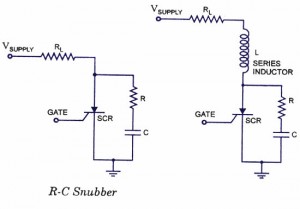SCR Voltage Ratings
(i) Breakover Voltage.
The minimum forward voltage, when the gate is open, at which SCR starts conducting heavily (that is turned-on) is called the breakover voltage. To specify this value, the gate is in the open-circuit condition and the junction temperature is at its maximum permitted value, although VFB0 is still a function of dv/dt. Though the SCR can be turned-on, with gate open, by making the supply voltage equal to breakover voltage, but in practice, the SCR is operated with supply voltage less than breakover voltage and it is turned-on by applying a small voltage (typically 1.5 V) to the gate. Commercially available SCRs have breakover voltages from about 50 V to 500 V.
(ii) Peak Forward Voltage.
This is the limiting positive anode voltage above which the SCR may get damaged. In general peak forward voltage (PFV) is larger than forward breakover voltage VFB0 so that there is some inherent protection for the device. However, if there is a voltage transient with an amplitude larger than the transient rating of the SCR, although it is unlikely to damage the device, it may lead to malfunctioning of the circuit if it causes the device to turn-on at the wrong instant. If the junction temperature is low, it is possible that the PFV is lesser than VFBQ.
(iii) Maximum On-State Voltage.
It is the maximum value of the voltage appearing across the device during the conduction. For an SCR with current load, the voltage across load is also included. Normally value of this voltage is of 1.5 V.
(iv) Peak Reverse Voltage.
The maximum reverse voltage (cathode positive with respect to anode) that can be applied to an SCR without conduction in the reverse direction, is called the peak reverse voltage (PRV) or peak inverse voltage (PIV).
Peak reverse voltage (PRV) is an important consideration while SCR is operating in an ac circuit. During negative half cycle of ac supply reverse voltage acts across the SCR and if it exceeds beyond PRV, there may be avalanche breakdown and SCR will get damaged if the current is not limited by the external circuit. Commercially available SCRs have PRV ratings upto 2.5 kV.
(v) Critical Rate of Rise of Voltage.
Critical rate of rise of voltage, dv/dt, is the maximum rate at which the voltage in the forward direction can rise without triggering the device. It is expressed in volts /microseconds.
It is found that sometimes an SCR unintentionally switches-on by itself during sudden variation of the applied anode voltage at a time when there is no gate current applied and the SCR is supposed to be in the forward blocking state. This false triggering is because of the capacitance possessed by the large area of junction J2. When the rate of rise of the applied voltage dV/dt is very large, the capacitive charging current, CdV/dt may become large enough to trigger the device. This is not likely to damage the device, but an unintended triggering may lead to either high di/dt through the SCR or large shortest circuit current which may lead to the failure of the device.
Snubber Circuit

One way of preventing false triggering due to capacitive charging current C [dV/dt] is by using an R-C snubber shown in figure. If a high-speed switching transient does appear on the supply voltage, its rate of rise is reduced at the anode because of the R-C circuit. The rate of the anode voltage rise dV/dt depends on load resistance RL as well as on the values of R and C. By including an inductor in series, as shown in fig.b, rate of rise of current dI/dt is also reduced in addition to decreasing of rate of rise of voltage.
(vi) Voltage Safety Factor.
To avoid puncture of SCR due to uncertain conditions, normal operating voltage is kept well below PRV value of the device. The operating voltage and PRV are related by voltage safety factor Vf defined as Vf = PRV/ √2x rms value of input voltage The normal value of V, lies between 2 and 2.5.

2 Comments
am so happy with this nice lesson. may power of God be with you ever
there is not updated scr voltage rating on circuit today.the vbo is given only 25 kv but there is 10 kv voltage rating scr are there.pls provide the updated information.
thanks
with warm regards,
ashwani